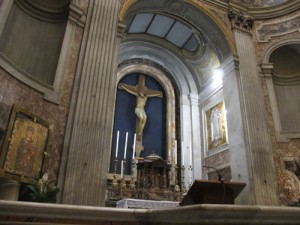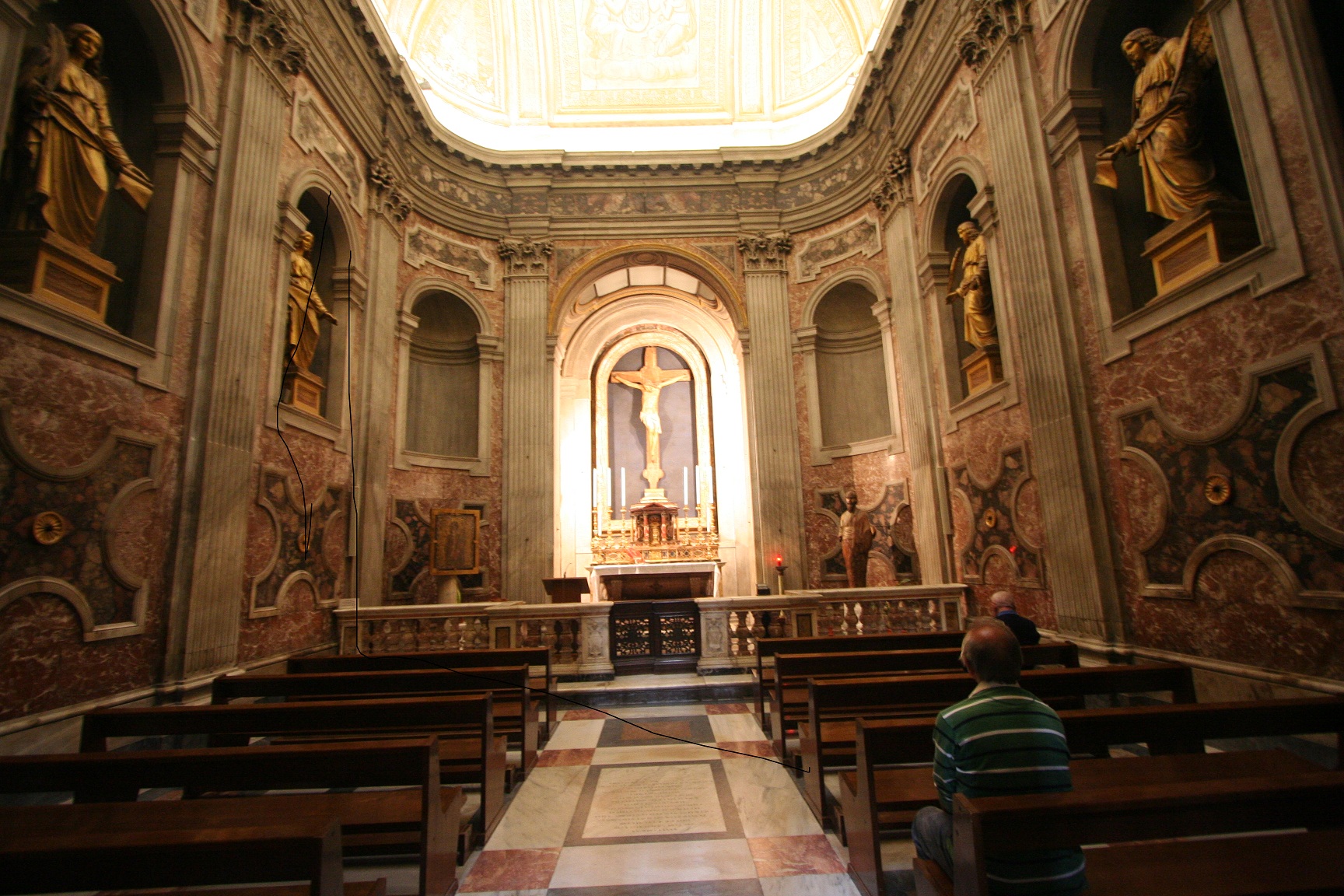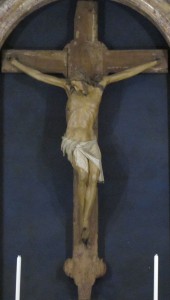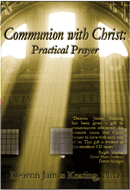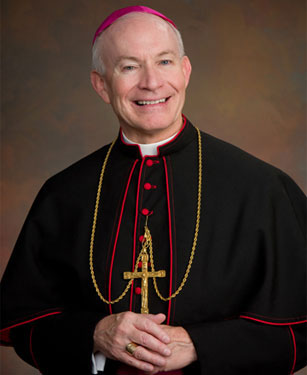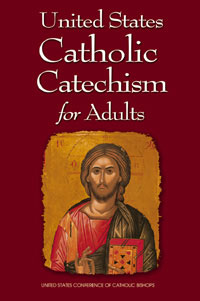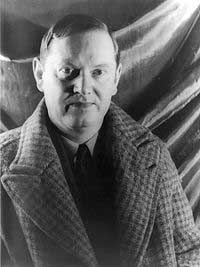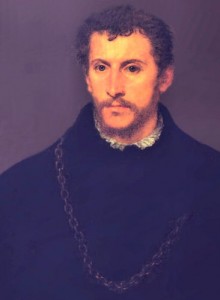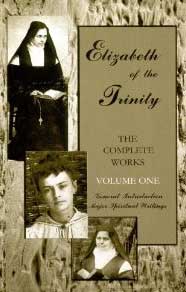[powerpress]
Day 1
From the writings of St. Ignatius of Loyola: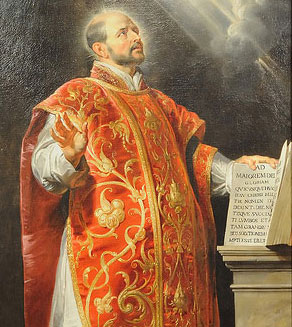
The moment you decided to use all your strength in praising, honoring, and serving God our Lord, that was the moment you entered battle with the world, raised your standards against it, and made yourself ready to reject all that is exalted by embracing all that is lowly. At the same time you resolved to accept with indifference positions high or low, honor or dishonor, riches or poverty, to be loved or hated, to be appreciated or scorned—in short, the world’s glory or the injuries it could inflict upon you
If we desire to live in honor and to be esteemed by our neighbors, then we shall never be solidly rooted in God our Lord, and it will be impossible for us to remain undisturbed when insults come our way
Our Father….
With St. Ignatius we pray:
Soul of Christ, sanctify me.
Body of Christ, save me.
Blood of Christ, inebriate me.
Water from the side of Christ, wash me.
Passion of Christ, strengthen me.
O Good Jesus, hear me.
Within Thy wounds hide me.
Suffer me not to be separated from thee.
From the malignant enemy defend me.
In the hour of my death call me.
And bid me come unto Thee,
That with all Thy saints,
I may praise thee
Forever and ever.
Amen.
St. Ignatius of Loyola, pray for us
Tags: st. ignatius of loyola
This entry was posted on Monday, July 23rd, 2012 at 4:10 pm
You can follow any responses to this entry through the RSS 2.0 feed.
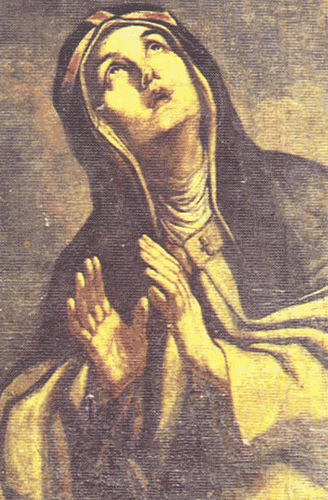 St. Bridget of Sweden…I never knew the power of the revelations to St. Bridget of Sweden until my friend Denise “reintroduced” them to me.  I say “reintroduced”, because I had bought the Pieta Prayer booklet (where they can be found) back in 1987. I offered them, really, only for a short while before packing the book away. But years later, after seeing how the revelations touched the heart of my
St. Bridget of Sweden…I never knew the power of the revelations to St. Bridget of Sweden until my friend Denise “reintroduced” them to me.  I say “reintroduced”, because I had bought the Pieta Prayer booklet (where they can be found) back in 1987. I offered them, really, only for a short while before packing the book away. But years later, after seeing how the revelations touched the heart of my dear friend, I dug the booklet out and started praying them again (as faithfully as I could). They are very powerful and beautiful. Meditating on the Passion of our Lord with the intensity called for in this particular devotion will change your life…are you ready?  How many of you out there have the Pieta prayer book and know the stories of St. Bridget of Sweden?
dear friend, I dug the booklet out and started praying them again (as faithfully as I could). They are very powerful and beautiful. Meditating on the Passion of our Lord with the intensity called for in this particular devotion will change your life…are you ready?  How many of you out there have the Pieta prayer book and know the stories of St. Bridget of Sweden?
(oh, be sure not to confuse her with St. Brigid of Kildare…it happens all the time)
Here  is the audio mp3 download of the 15 Prayers of St. Bridget as offered by Bruce McGregor and Denise Wharton
[powerpress ]
You can find the text for the prayers hereÂ
Here is the chapel in St. Paul’s Outside the Walls in Rome where St. Bridget received the private revelation of the 15 prayers…….
Of course, St. Bridget is more than just her prayers…ordinary woman, extraordinary life!. To learn more about St. Bridget of Sweden, take a look at this:
Tags: audio, feast day, Pieta Prayer, pieta prayer book, prayers, rome, st bridget of sweden, St. Paul Outside the Walls, Sweden, women of the middle ages
This entry was posted on Monday, July 23rd, 2012 at 1:00 am
You can follow any responses to this entry through the RSS 2.0 feed.
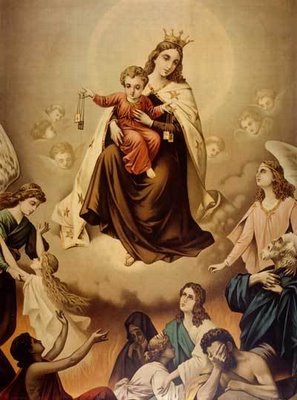 The Feast of Our Lady of Mount Carmel…
The Feast of Our Lady of Mount Carmel…
A prayer to Our Lady of Mt. Carmel
[powerpress]
from About.com
“According to the traditions of the Carmelite order, on July 16, 1251, the Blessed Virgin Mary appeared to St. Simon Stock, a Carmelite. During the vision, she revealed to him the Scapularof Our Lady of Mount Carmel, popularly known as the “Brown Scapular.” A century and a quarter later, the Carmelite order began to celebrate on this date the Feast of Our Lady of Mount Carmel.
The Carmelites had long claimed that their order extended back to ancient times-indeed, that it was founded on Mount Carmel in Palestine by the prophets Elijah and Elisha. While others disputed this idea, Pope Honorius III, in approving the order in 1226, seemed to accept its antiquity. The celebration of the feast became wrapped up with this controversy, and, in 1609, after Robert Cardinal Bellarmine examined the origins of the feast, it was declared the patronal feast of the Carmelite order.
The feast celebrates the devotion that the Blessed Virgin Mary has to those who are devoted to her, and who signal that devotion by wearing the Brown Scapular. According to tradition, those who wear the scapular faithfully and remain devoted to the Blessed Virgin until death will be granted the grace of final perseverance and be delivered from Purgatory early.”
I’m all about the cloth scapular rather than the medal or wood ones. It’s intent is to be a habit…who wears metal or wood clothing? I realize papal permission was given to wear the medal instead, but that was for missionaries in the jungle where the climate disintigrated the cloth quickly.  Really, would it really be a big problem, for those committed to the devotion, to wear the cloth scapular for solidarity sake?  Anyway…
Here are a few of the Carmelites dearest to our hearts:
Also THE SIXTEEN CARMELITE MARTYRS OF COMPIEGNE, but that’s tomorrow….
Tags: blessed virgin mary, brown scapular, catholic, catholic podcast, catholic prayer, cathollc spirituality, devotion, lady of mount carmel, Simon Stock
This entry was posted on Monday, July 16th, 2012 at 12:07 am
You can follow any responses to this entry through the RSS 2.0 feed.
Fr. Joseph Fessio S.J. has such an incredible depth of knowledge and experience, that it is gift to discuss 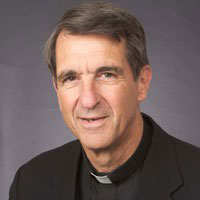 any topic with him, but it is especially wonderful to reflect with him on “the language of the liturgy.”  In this episode we discuss 2 books published by Ignatius Press, “Benedict XVI’s Reform” by Msgr. Nicola Bux and “The Voice of the Church at Prayer” by Fr. Uwe Michael Lang.  We discuss the primacy of place the Sacred Liturgy holds in our lives and the importance of offering it worthily.  Fr. Fessio helps us to understand the history of the reform, especially in its expression through our language.  We also discuss  the importance of elevating our understanding and action as opposed to “dumbing it down”.  We also look at the important role the use of Latin plays in enhancing the sense of the sacred in our sacramental expression.  Msgr. Bux’s book does an incredible job of closely examining the nature of  liturgical reform nurtured by Pope Benedict XVI, while Fr. Lang’s book offers a fascinating history of the language used in our celebrations.  Not just for scholars, these works offer invaluable insight into the heart of the liturgy we participate in.
any topic with him, but it is especially wonderful to reflect with him on “the language of the liturgy.”  In this episode we discuss 2 books published by Ignatius Press, “Benedict XVI’s Reform” by Msgr. Nicola Bux and “The Voice of the Church at Prayer” by Fr. Uwe Michael Lang.  We discuss the primacy of place the Sacred Liturgy holds in our lives and the importance of offering it worthily.  Fr. Fessio helps us to understand the history of the reform, especially in its expression through our language.  We also discuss  the importance of elevating our understanding and action as opposed to “dumbing it down”.  We also look at the important role the use of Latin plays in enhancing the sense of the sacred in our sacramental expression.  Msgr. Bux’s book does an incredible job of closely examining the nature of  liturgical reform nurtured by Pope Benedict XVI, while Fr. Lang’s book offers a fascinating history of the language used in our celebrations.  Not just for scholars, these works offer invaluable insight into the heart of the liturgy we participate in.
[powerpress]
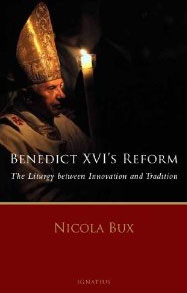 You can find it at ignatius.com
You can find it at ignatius.com
Nicola Bux is a priest of the Archdiocese of Bari and a professor of eastern liturgy and sacramental theology. He has studied and taught in Jerusalem and in Rome. He is a consultor to the Congregations for the Doctrine of the Faith and for the Causes of Saints and consultant of the international Catholic theological journal Communio. He was recently named a consultor to the Office of Liturgical Celebrations of the Supreme Pontiff.
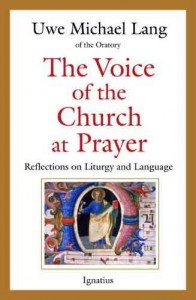 It also can be found here
It also can be found here
Uwe Michael Lang, a native of Germany, is a priest of the Congregation of the Oratory of St Philip Neri in London. At present, he is a staff member of the Congregation for Divine Worship and the Discipline of the Sacraments and teaches at the Pontifical Institute for Christian Archeology and at the Master’s program in “Architecture, Sacred Art and Liturgy” at the UniversitÀ Europea di Roma. In September 2008, he was appointed a Consultor to the Office for the Liturgical Celebrations of the Supreme Pontiff. His book Turning Towards the Lord (2nd edition, Ignatius, 2009), with a preface by then-Cardinal Joseph Ratzinger, has been published in several languages. Most recently, he has edited and contributed to the volume The Genius of the Roman Rite: Historical, Theological and Pastoral Perspectives on Catholic Liturgy (Hillenbrand Books, 2010).
Tags: catholic, catholic podcast, catholic prayer, cathollc spirituality
This entry was posted on Friday, July 13th, 2012 at 10:59 am
You can follow any responses to this entry through the RSS 2.0 feed.
[powerpress]Msgr. Esseff shares a poignant reflection on rejection, loss, suffering, and aloneness. 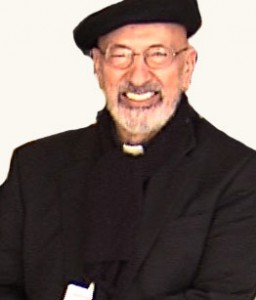  We experience various forms of suffering, but as it is said “success has a hundred mothers, failure is an orphanâ€.  Why is the cross so important to those who are united with Him?  Its in the cross that we experience His presence.  He shares a very compelling story he was given permission to share, which concerns a Sister,
 We experience various forms of suffering, but as it is said “success has a hundred mothers, failure is an orphanâ€.  Why is the cross so important to those who are united with Him?  Its in the cross that we experience His presence.  He shares a very compelling story he was given permission to share, which concerns a Sister,  Mother Teresa, anger, forgiveness and love…it’s a heartbreaking tale…one where ultimately love prevails.  â€You’ll always have the gift and you’ll always have the cross.†– Bl. Mother Teresa
Mother Teresa, anger, forgiveness and love…it’s a heartbreaking tale…one where ultimately love prevails.  â€You’ll always have the gift and you’ll always have the cross.†– Bl. Mother Teresa
To obtain a copy of Msgr. Esseff’s book byvisiting here
Be sure to visit Msgr. Esseff’s website “Building a Kingdom of  Love”
Tags: blessed mother teresa, catholic, catholic podcast, catholic prayer, cathollc spirituality, forgiveness, John Esseff, missionaries of charity, mother teresa, suffering, the cross
This entry was posted on Tuesday, July 10th, 2012 at 8:26 am
You can follow any responses to this entry through the RSS 2.0 feed.
Heart of Hope Part 3 -Â What is Redemptive Suffering…using love and the energy of love to redirect pain as an intercessory prayer for another…how it makes sense and is no longer meaningless
[powerpress]
Deacon James Keating, PhD, the director of Theological Formation for the Institute for Priestly Formation, located at Creighton University, in Omaha, is making available to â€Discerning Hearts†and all who listen, his series of programs entitled “The Heart of Hopeâ€.
This extraordinarily popular series explores the work of suffering in the Christian life and how God can use it to transform the heart of the individual and the world. 
The “Heart of Hope† tackles a very tough subject…the gift of suffering in the Christian life. Deacon Keating guides us well.
.
For more information on the “Institute of Priestly Formation†and for other material available by Deacon Keating, just click here
Don’t forget to pickup a copy of “Communion with Christ†, it is one of the best audio sets on prayer…ever!
Check out Deacon Keating’s “Discerning Heart†page
Tags: catholic, catholic podcast, catholic prayer, cathollc spirituality, Deacon James Keating, Deacon Keating, intercessory prayer, PhD, theological formation
This entry was posted on Monday, July 9th, 2012 at 10:22 am
You can follow any responses to this entry through the RSS 2.0 feed.
[powerpress] I had the opportunity to speak with Msgr. Esseff, who  is conducting a spiritual retreat for the Sisters of the 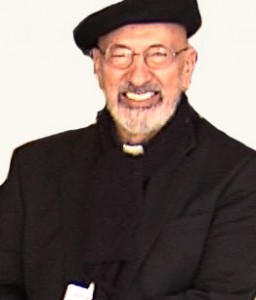 Missionaries of Charity in Sydney, Australia.  He shares with us the teachings from the first day, which is on the principal and foundation of prayer as taught by St. Ignatius of Loyola.
Missionaries of Charity in Sydney, Australia.  He shares with us the teachings from the first day, which is on the principal and foundation of prayer as taught by St. Ignatius of Loyola.
Msgr. Esseff begins by reflecting on the Awe of God and the difference between “being” and “becoming”. Â He shares a special memory of an experience that helped him to understand this which occurred when he was a young boy on his grandfather’s farm. Â Many years later, he would learn this was a basic teaching of St. Thomas Aquinas on the nature of God and creation. Â God is being and creation (including man) is becoming.
 With that foundation, Msgr. Esseff proceeds to teach us that all of our are becoming therefore because mankind has a soul and has the capacity for reflection, we have the power to glorify God. Â That is the first call we have, to glorify God. Â To often we focus on our selves and what serves our needs. Â St. Ignatius would say, that instead when faced with a decision or direction, each human being is called to discern, to ask whether if this is what God wants or is this is what I want. Â The key is to take ask the Father “What do you want us to do?” Â This is discernment at its basic level.
With that foundation, Msgr. Esseff proceeds to teach us that all of our are becoming therefore because mankind has a soul and has the capacity for reflection, we have the power to glorify God. Â That is the first call we have, to glorify God. Â To often we focus on our selves and what serves our needs. Â St. Ignatius would say, that instead when faced with a decision or direction, each human being is called to discern, to ask whether if this is what God wants or is this is what I want. Â The key is to take ask the Father “What do you want us to do?” Â This is discernment at its basic level.
To obtain a copy of Msgr. Esseff’s book byvisiting here
Be sure to visit Msgr. Esseff’s website “Building a Kingdom of  Love”
Tags: catholic, catholic podcast, catholic prayer, cathollc spirituality, Esseff, John Esseff, the Sisters of the Missionaries of Charity
This entry was posted on Sunday, July 8th, 2012 at 5:50 pm
You can follow any responses to this entry through the RSS 2.0 feed.
It is always a delight to talk with Fr. Robert Spitzer!  His sure brilliance, combined with his infectious joy 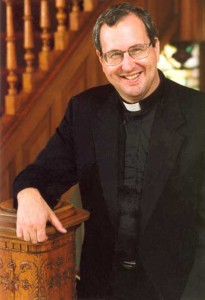 and good humor, is so engaging that any topic he leads us on becomes an adventure.  With “Cosmic Origins”, a soon to be released DVD, Fr. Spitzer and a group of physicists and academic heavyweights exploring modern scientific theories about how the universe came to exist.  I would call this a “mathematical apologetic”, which is so beautifully points to the greater “purpose” of our creator, that I couldn’t help but smile through the entire presentation.  Stunning, wonderful…and so much fun!
and good humor, is so engaging that any topic he leads us on becomes an adventure.  With “Cosmic Origins”, a soon to be released DVD, Fr. Spitzer and a group of physicists and academic heavyweights exploring modern scientific theories about how the universe came to exist.  I would call this a “mathematical apologetic”, which is so beautifully points to the greater “purpose” of our creator, that I couldn’t help but smile through the entire presentation.  Stunning, wonderful…and so much fun!
[powerpress]
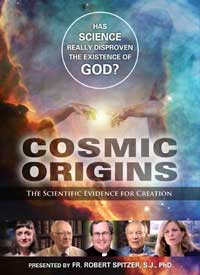 To learn more about this film and how you can arrange screenings for your parish or group go here
To learn more about this film and how you can arrange screenings for your parish or group go here
Cosmic Origins explains what we know about the beginning and nature of the universe, as well as its transcendent implications in clear, easy-to-understand terms. The 49-minute film weaves together a compelling narrative from academics and credentialed scientists pointing toward a very Catholic understanding of how the universe came to exist.
Cosmic Origins is distributed by Ignatius Press.
Tags: catholic, catholic podcast, catholic prayer, cathollc spirituality
This entry was posted on Friday, July 6th, 2012 at 9:55 am
You can follow any responses to this entry through the RSS 2.0 feed.
Heart of Hope Part 2 -Â The agony of emotional suffering and opportunities for deeper union with Jesus; the reason for pastoral ministry
[powerpress]
Deacon James Keating, PhD, the director of Theological Formation for the Institute for Priestly Formation, located at Creighton University, in Omaha, is making available to â€Discerning Hearts†and all who listen, his series of programs entitled “The Heart of Hopeâ€.
This extraordinarily popular series explores the work of suffering in the Christian life and how God can use it to transform the heart of the individual and the world. 
The “Heart of Hope† tackles a very tough subject…the gift of suffering in the Christian life. Deacon Keating guides us well.
.
For more information on the “Institute of Priestly Formation†and for other material available by Deacon Keating, just click here
Don’t forget to pickup a copy of “Communion with Christ†, it is one of the best audio sets on prayer…ever!
Check out Deacon Keating’s “Discerning Heart†page
Tags: catholic, catholic podcast, catholic prayer, cathollc spirituality, Deacon James Keating, Deacon Keating, PhD, theological formation
This entry was posted on Monday, July 2nd, 2012 at 2:29 pm
You can follow any responses to this entry through the RSS 2.0 feed.
USCCA16- Episode 16- Confirmation:Â Consecrated for Mission
[powerpress]
Archbishop Lucas offers insights on the US Catholic Catechism for Adults Chapter 16:
“When we are responsive to the grace of Confirmation and the seven gifts of the Holy Spirit, we begin to bear the fruits of the Spirit.  The tradition of the Church names twelve frutis of the Holy Spirit:  love, joy, peace, patience, kindness, goodness, generosity, gentleness, faithfulness, modesty, self-control, and chastity”
The Most Reverend George J. Lucas leads the Archdiocese of Omaha.Â
For other episodes in the visit our Archbishop George Lucas page
This programs is based on:
More information can be found here.
We wish to thank the USCCB for the permissions granted for use of  relevant material used in this series.
Also we wish to thank Omar Gutierrez, Teresa Monaghen, and Bruce McGregor for their vocal talents in this episode.
Tags: Archbishop Lucas, catholic, catholic podcast, catholic prayer, cathollc spirituality, confimration, Consecrated, George Lucas, gifts of the holy spirit, holy spirit, united states catholic catechism for adults
This entry was posted on Monday, July 2nd, 2012 at 12:56 pm
You can follow any responses to this entry through the RSS 2.0 feed.
I love the writing of Evelyn Waugh…his prose are some of the best of our time, if not of all time.  And when that talent is used to pen a biography of the heroic English martyr, Edmund Campion, a tremendous blessing has been given to all who gleen it’s pages.  What a story…what a life.  We are joined once again by the wonderful Vivian Dudro to discuss this incredible work, as well as the life and times of this great saint.
[powerpress]
 You can find the book here
You can find the book here
From the description:
Evelyn Waugh presented his biography of St. Edmund Campion, the Elizabethan poet, scholar and gentleman who became the haunted, trapped and murdered priest as “a simple, perfectly true story of heroism and holiness.â€
But it is written with a novelist’s eye for the telling incident and with all the elegance and feeling of a master of English prose. From the years of
success as an Oxford scholar, to entry into the newly founded Society of Jesus and a professorship in Prague, Campion’s life was an inexorable progress towards the doomed mission to England. There followed pursuit, betrayal, a spirited defense of loyalty to the Queen, and a horrifying martyr’s death at Tyburn.
Tags: catholic, catholic podcast, catholic prayer, cathollc spirituality, edmund campion, english martyrs, english reformation, Evelyn Waugh, holiness, ignatius press, mission
This entry was posted on Monday, July 2nd, 2012 at 12:47 pm
You can follow any responses to this entry through the RSS 2.0 feed.
Show 10 ” Building a Kingdom of Love” – Who is a true leader?  What does sloth really look like?
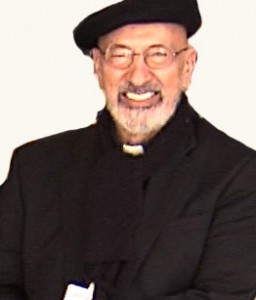
[powerpress]
Msgr. Esseff reflects on the major area that separates us from God…it’s sloth.  What is the truth about sloth? What does laziness really look like? To depend on oneself more than on God….”that I can do anything”, “I can do it”….the man of faith says “God can do it”.  Jesus said without the Father, he could do nothing.  That He does only what the Father tells him.  The solution to sloth is obedience…the obedience to the will of the Father.
Msgr. Esseff takes a strong look at King David and his actions after he becomes king…a leader who became consumed with himself.  Then he looks at a true leader…Jesus.  Msgr. has a strong message and challenge for families, our country, the world and our Church.
Msgr. John A. Esseff is a Roman Catholic priest in the Diocese of Scranton. He was ordained on May 30th 1953, by the late Bishop William J. Hafey, D.D. at St. Peter’s Cathedral in Scranton, PA. Msgr. Esseff served a retreat director and confessor to Blessed Mother Teresa.   He continues to offer direction and retreats for the sisters of the missionaries of charity around the world. Msgr. Esseff encountered St.  Padre Pio,  who would become a spiritual father to him. He has lived in areas around the world,  serving  in the Pontifical missions, a Catholic organization established by Bl. Pope John Paul II to bring the Good News to the world especially to the poor. Msgr. Esseff assisted the founders of the Institute for Priestly Formation and continues to serve as a spiritual director for the Institute. He continues to  serve as a retreat leader and director to bishops, priests and sisters and seminarians and other religious leaders around the world. Â
To obtain a copy of Msgr. Esseff’s book byvisiting here
Be sure to visit Msgr. Esseff’s website “Building a Kingdom of  Love”
Tags: catholic, catholic podcast, catholic prayer, cathollc spirituality, Good News, leadership, retreat, Roman Catholic, sloth, zeal
This entry was posted on Sunday, July 1st, 2012 at 9:23 am
You can follow any responses to this entry through the RSS 2.0 feed.
[powerpress = “Vatican_Radio”]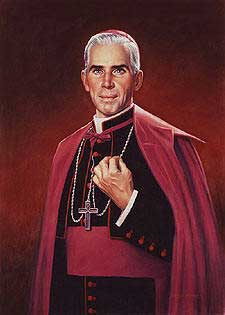
(Vatican Radio) Pope Benedict XVI on Thursday signed a decree recognizing the heroic virtue of the Servant of God, Archbishop Fulton John Sheen, allowing him to be styled as Venerable. This is the second major step in the process of his cause for canonization. Archbishop Sheen was ordained a priest of the Diocese of Peoria, Illinois, in 1919. He served the Church in Peoria for more than three decades, before being appointed auxiliary bishop of the Archdiocese of New York in 1951, and became the Bishop of Rochester, NY in 1966. During his years of service, he became the leading religious radio and television personality in the United States, while continuing to publish books and articles prolifically.
Bishop Daniel Jenky of Peoria told Vatican Radio the declaration gives US Catholics renewed confidence in a timely intercessor. “I believe [Ven. Fulton Sheen] is the perfect person to emulate in our current grave difficulties,†said Bishop Jenky, citing Sheen’s successful engagement with the culture at a time when National Socialism, the Great Depression, the Communist threat and growing moral challenges from many different quarters. “[Sheen] was not afraid to confront what was wrong,†Bishop Jenky said. “He would dialogue with the world,†he explained, “but – I also know – he had steel in him.â€
Tags: archishop fulton sheen, catholic, catholic podcast, catholic prayer, cathollc spirituality, new evangelization
This entry was posted on Saturday, June 30th, 2012 at 2:17 pm
You can follow any responses to this entry through the RSS 2.0 feed.
Episode 18 Beginning to Pray:  “Heaven in Faith”  Day 9 Prayer 2- “God who is rich in mercy, impelled by His exceeding love, even when we were dead because of our sins, has brought us back to life in Christ Jesus.”
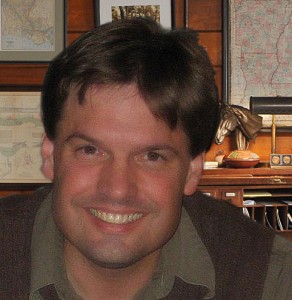
[powerpress]
Dr. Anthony Lilles is a Catholic husband and father of three teaching Spiritual Theology at St. John Vianney Theological Seminary. He  teaches spiritual theology and spiritual direction to transitional deacons, and the spiritual classics to the men who enter the Spirituality Year, a year of prayer in preparation for seminary formation.  He is the author of the “Beginning to Pray”  catholic blog spot.
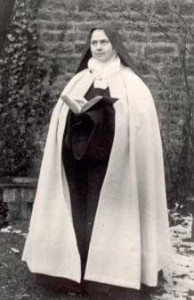 From “Heaven in Faith: Day 9 Prayer 2” found in The Complete Works vol 1:
From “Heaven in Faith: Day 9 Prayer 2” found in The Complete Works vol 1:
37.  “If anyone should affirm to me that to find the bottom of the abyss is to be immersed in humility, I would not contradict him.  However, it seems to me that to be plunged into humility is to be plunged into God, for God is the bottom of the  abyss.  This is why humility, like charity, is always capable of increasing.”
For other episodes in the series visit the Discerning Hearts page for Dr. Anthony Lilles
We would like to offer heartfelt thanks to
Miriam Gutierrez for providing for us “the voice” of Blessed Elizabeth for this series
Tags: Anthony Lilles, blessed elizabeth of the trinity, carmelites, catholic, catholic podcast, catholic prayer, cathollc spirituality, heaven and faith, Spiritual Theology, St. John Vianney Theological Seminary
This entry was posted on Saturday, June 30th, 2012 at 11:05 am
You can follow any responses to this entry through the RSS 2.0 feed.
Join Bruce and I as we discuss with Mike Aquilina the powerful and at the same time, poignant witness of the Holy Roman 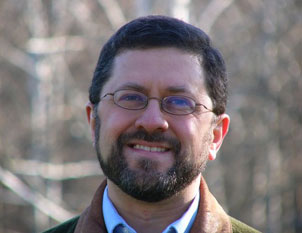 Martyrs[powerpress]
Martyrs[powerpress]
From Mike’s great website The Way of the Matyrs: ROMAN PROTOMARTYRS
Monday June 30th 2008, 10:23 am
Filed under: PatristicsToday’s the feast of the first Roman Martyrs. Theirs is a story you just have to hear. But first we have to backtrack a little bit.
In July of A.D. 64, during the tenth year of Nero’s reign, a great fire consumed much of the city of Rome. The fire raged out of control for seven days — and then it started again, mysteriously, a day later. Many in Rome knew that Nero had been eager to do some urban redevelopment. He had a plan that included an opulent golden palace for himself. The problem was that so many buildings were standing in his way — many of them teeming wooden tenements housing Rome’s poor and working class.
The fire seemed too convenient for Nero’s purposes — and his delight in watching the blaze didn’t relieve anybody’s suspicions. If he didn’t exactly fiddle while Rome burned, he at least recited his poems. Nero needed a scapegoat, and an upstart religious cult, Jewish in origin and with foreign associations, served his purposes well. Nero, who was a perverse expert at human torment, had some of its members tortured till they were so mad they would confess to any crime. Once they had confessed, he had others arrested.
He must have known, however, that the charges would not hold up. So he condemned them not for arson, or treason, or conspiracy, but for “hatred of humanity.â€
To amuse the people, he arranged for their execution to be a spectacle, entertainment on a grand scale. The Roman historian Tacitus (who had contempt for the religion, but greater contempt for Nero) describes in gruesome detail the tortures that took place amid a party in Nero’s gardens.
Mockery of every sort was added to their deaths. Covered with the skins of beasts, they were torn by dogs and perished, or were nailed to crosses, or were doomed to the flames. These served to illuminate the night when daylight failed. Nero had thrown open the gardens for the spectacle, and was exhibiting a show in the circus, while he mingled with the people in the dress of a charioteer or drove about in a chariot. Hence, even for criminals who deserved extreme and exemplary punishment there arose a feeling of compassion; for it was not, as it seemed, for the public good, but to glut one man’s cruelty, that they were being punished.
That is all we know about the first Roman martyrs. We know none of their names. Tacitus doesn’t tell us why they were willing to die this way rather than renounce their faith. Yet this should be an important question for us to consider. Why did the martyrs do this? What prepared them to face death so bravely? To what exactly did they bear witness with their death?
The answers to these questions (and many more) can be found in the rest of the article, at the archive of Touchstone Magazine. The article originated in a talk I gave in Rome in 2005 on the feast of the Roman Martyrs. It’s called “The Roman Martyrs and Their Mass.â€
I also treat the subject in my book The Resilient Church: The Glory, the Shame, & the Hope for Tomorrow.
Tags: catholic, catholic podcast, catholic prayer, cathollc spirituality, Holy Roman Martyrs, martyrdom, martyrs, mike aquilina, Roman Martyrs, rome
This entry was posted on Saturday, June 30th, 2012 at 10:47 am
You can follow any responses to this entry through the RSS 2.0 feed.

